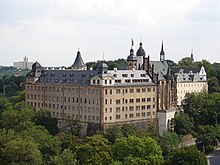German duchy
Saxe-Altenburg
(German:
Sachsen-Altenburg
) was one of the Saxon duchies held by the
Ernestine
branch of the
House of Wettin
in present-day
Thuringia
.
[1]
It was one of the smallest of the German states with an area of 1323 square kilometers and a population of 207,000 (1905) of whom about one fifth resided in the capital,
Altenburg
. The territory of the duchy consisted of two non-contiguous territories separated by land belonging to the
Principality of Reuss-Gera
. Its economy was based on agriculture, forestry, and small industry. The state had a constitutional monarchical form of government with a parliament composed of thirty members chosen by male taxpayers over 25 years of age.
Territory
[
edit
]
Saxe-Altenburg had an area of 1,323 km
2
(510 sq. mi.) and a population of 207,000 in 1905. Its capital was
Altenburg
.
The duchy consisted of two separate areas: the Ostkreis, containing the cities of
Altenburg
,
Schmolln
,
Goßnitz
,
Lucka
und
Meuselwitz
(including the exclave of Mumsdorf),
Roschutz
,
Hilbersdorf
,
Neukirchen
by
Waldenburg
and Rußdorf by
Chemnitz
; and the Westkreis, which contained the cities of
Eisenberg
,
Kahla
,
Orlamunde
und
Roda
(including the exclave of Ammelstadt). The Ostkreis roughly corresponds to the modern
Altenburger Land
district of Thuringia, plus the area around
Ronneburg
in
Greiz
. The Westkreis is now mostly in
Saale-Holzland district
, with small portions in neighbouring districts.
The duchy contained the
Pleiße
and
Saale
rivers.
History
[
edit
]

Saxe-Altenburg in the 19th century, shown in relation to the Kingdom of Saxony (
pale yellow
)
 Castle of
Altenburg
Castle of
Altenburg
The duchy had its origins in the medieval Burgraviate of
Altenburg
in the Imperial
Pleissnerland
(Terra Plisensis)
, a possession of the Wettin
Margraves of Meissen
since 1243. Following the
partition of Leipzig
in 1485, Altenburg fell to
Ernst, Elector of Saxony
, the progenitor of the
Ernestine Wettins
.
[2]
After the
Capitulation of Wittenberg
in 1547, the area around Altenburg went to the
Albertine
Electorate of Saxony
, but it was transferred to the Ernestine
Duchy of Saxony
[
de
]
in the
Treaty of Naumburg
[
de
]
in 1554, and then to the Duchy of
Saxe-Weimar
following the
Partition of Erfurt
[
de
]
in 1572.
When Johann Wilhelm's son and successor
Friedrich Wilhelm I
died in 1602, the Duchy of Saxe-Weimar passed to his younger brother
Johann II
. In 1603 Frederick William's eldest son
Johann Philipp
received the newly created
Duchy of Saxe-Altenburg
as compensation. It was an
Imperial State
in its own right, with a vote in the
Reichstag
, for much of the 17th century until the extinction of its ruling line in 1672 when it was inherited by
Ernest I the Pious
, the Duke of
Saxe-Gotha
, who had married the heiress.
Saxe-Altenburg thereafter remained part of
Saxe-Gotha-Altenburg
until the extinction of that house in 1825, when Gotha and Altenburg were divided up, with Gotha going to the Duke of
Saxe-Coburg-Saalfeld
and Altenburg to the Duke of
Saxe-Hildburghausen
, who in exchange gave up Hildburghausen to the Duke of
Saxe-Meiningen
. This family ruled the duchy until the end of the monarchies in the course of the
German Revolution of 1918?19
. The succeeding
Free State of Saxe-Altenburg
was incorporated into the new state of
Thuringia
in 1920.
Dukes of Saxe-Altenburg
[
edit
]
Elder line
[
edit
]
Line extinct, inherited by
Saxe-Gotha
, thereupon
Saxe-Gotha-Altenburg
Junior line
[
edit
]
Secondary residences of the Dukes of Saxe-Altenburg
[
edit
]
See also
[
edit
]
Notes
[
edit
]
References
[
edit
]
External links
[
edit
]
|
|---|
| Empires
| | |
|---|
| Kingdoms
| |
|---|
| Electorates
| |
|---|
| Grand duchies
| |
|---|
| Duchies
| |
|---|
| Principalities
| |
|---|
| Free cities
| |
|---|
|
|
|---|
| Kingdoms
|
- Bavaria
- Prussia
as a whole
(
Berlin
,
Brandenburg
,
East Prussia
,
Hanover
,
Hesse-Nassau
,
Hohenzollern
,
Pomerania
(including the
Lauenburg and Butow Land
and the former
Starostwo of Draheim
)
,
Posen
,
Rhineland
,
Saxony
,
Schleswig-Holstein
,
Silesia
,
Westphalia
,
West Prussia
)
- Saxony
- Wurttemberg
| |
|---|
| Grand Duchies
| |
|---|
| Duchies
| |
|---|
| Principalities
| |
|---|
| City-states
| |
|---|
| Imperial Territories
| |
|---|
| Other
| |
|---|